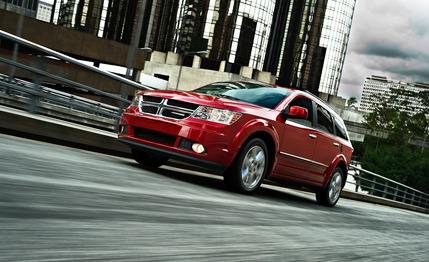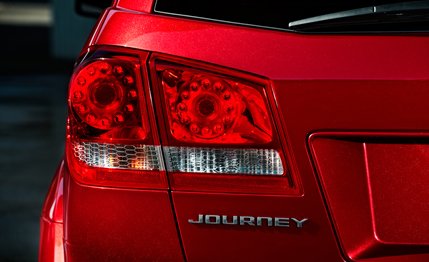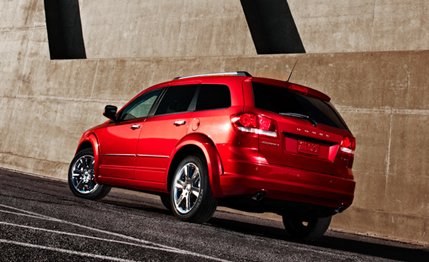 First Drive Review
First Drive Review
Chrysler is waging a war against the lame reputation of its own products—a war on dullness, if you will. The battlefield strategy? Thoroughly refresh or totally redo pretty much every Chrysler, Dodge, and Jeep model for 2011, an audacious rollout—a Mopar “shock and awe”—that arguably began with the excellent new Grand Cherokee and will culminate with the debut of the 2011 Chrysler 300 at the Detroit auto show this January.
But easily lost behind tip-of-the-spear debuts such as the all-new Grand Cherokee and Dodge Charger are foot soldiers like the Dodge Journey, which is merely overhauled. To transform the rental-fleet darling Journey, Chrysler has granted the crossover more power, a sharper chassis, and a vastly improved interior for 2011.
Priorities Inside Out
Dodge focused less on the Journey’s styling and more on its interior and chassis, a decision we support. And so the exterior changes are minimal. Up front, all models get a new grille and V-6 Journeys a square-jawed front bumper. Circular LED taillights and a revised rear bumper soften the rear end’s previous angularity, and new 19-inch wheels enter the range on higher trim levels.

Open any door, however, and the Journey is virtually unrecognizable. No longer is the cabin a hard-knock blend of Fisher-Price and ugly. Shiny plastic is as scarce inside the 2011 model as soft-touch materials were in the 2010. The cabin’s centerpiece is the new dashboard, wrapped in a low-gloss, one-piece padded panel with bezeled components, zero-gap tolerances, a new steering wheel, and classy black-on-white instruments set within Mercedes-like angled wells. Six interior color themes boldly embrace chroma and contrast like no other crossover in the class—one striking combo features ivory leather and orange stitching against black carpets—making the gray-scale misery of the previous Journey a hazy memory.
With the prior model’s most loathsome interior characteristics banished, the Journey’s innately sensible traits—the comfortably elevated seating position, standard underfloor bins in the second-row, and reasonable space for the occasional carpool in three-row form—are vastly more appreciable. Over-the-shoulder vision remains at a premium due to the Journey’s high waistline and chunky pillars, but the sightlines can be enhanced by dropping the revised second- and third-row headrests forward onto the seatbacks when they’re not in use.
An Interesting Journey
Two engines are available for 2011. The 2.4-liter four-cylinder carries over with 173 hp and 166 lb-ft of torque and is still mated to a four-speed autobox. It is the exclusive domain of the base Express trim level. The rest of the Journey lineup—Mainstreet, R/T, Crew, and Lux trims—features Chrysler’s new 3.6-liter Pentastar V-6, tuned for 283 hp and 260 lb-ft of torque and mated to a six-speed manumatic. All-wheel drive is an option for all but the front-wheel-drive-only Express. Our brief stint in a Journey Lux with all-wheel drive, estimated to weigh somewhere north of 4200 pounds, proved that the 2011 Journey isn’t a total slug. The V-6 has a far easier time with 4200 pounds than with, say, 5000 pounds of Dodge Durango, and we estimate the Pentastar-powered Journey should hit 60 mph in the low-seven-second range.

The squiggly, bucking coastal roads north of San Francisco provided as appropriate a venue as one could find to evaluate the Journey’s heavily reworked chassis, which benefits from revised rear-suspension geometry; larger, retuned shocks; new spring rates; new jounce bumpers; and beefier steering components. Within a few miles, we were impressed with the Journey’s composure and feedback. Our tester was shod with the top-dog 225/55-19 all-season tires, which handled our flogging with remarkably little protest. Additional credit for the planted feel goes to a partnership between the electronic all-wheel-drive and stability-control systems; they conspire to send power proactively to the rear wheels while cornering at speeds between 25 and 53 mph, roughly the same range of speeds we could safely explore on those bumpy ribbons of asphalt.
Competitive, but Will Anyone Believe It?
Within its competitive set, which includes mid-size vehicles like the Hyundai Santa Fe and larger three-row trucks like the Honda Pilot and Mazda CX-9, the Journey is aggressively priced at $22,995. The bump of $1400 over the 2010 model is more than worth it given the 2011’s newfound competence. The $24,995 Journey Mainstreet represents $2000 well spent for the stronger engine and transmission alone, although Dodge tosses in larger wheels (17 inches), dual exhaust tips, body-color mirrors, cargo area accessories, Sirius satellite radio, and more. From there, Journey prices leap to $28,995 for the R/T and $29,990 for the Crew, which are mechanically identical and laden with roughly the same smattering of creature comforts (remote start, premium audio with a hard drive, automatic climate control, and more) but delineated by specific paint schemes and 19-inch wheel designs. The Lux piles on heated leather seats, multiple parking assistants, a premium instrument cluster, and shiny chrome-clad wheels, for $33,490.
Three years after its introduction, the Journey is finally the crossover it should have been all along and is perhaps capable of bettering its last-place finish in its only comparison test. But that could be only half the battle. The other half? Since the 2011 looks so much like the 2008–10 Journey, Dodge might have to spend as much money marketing the much-improved crossover as it spent fixing it.